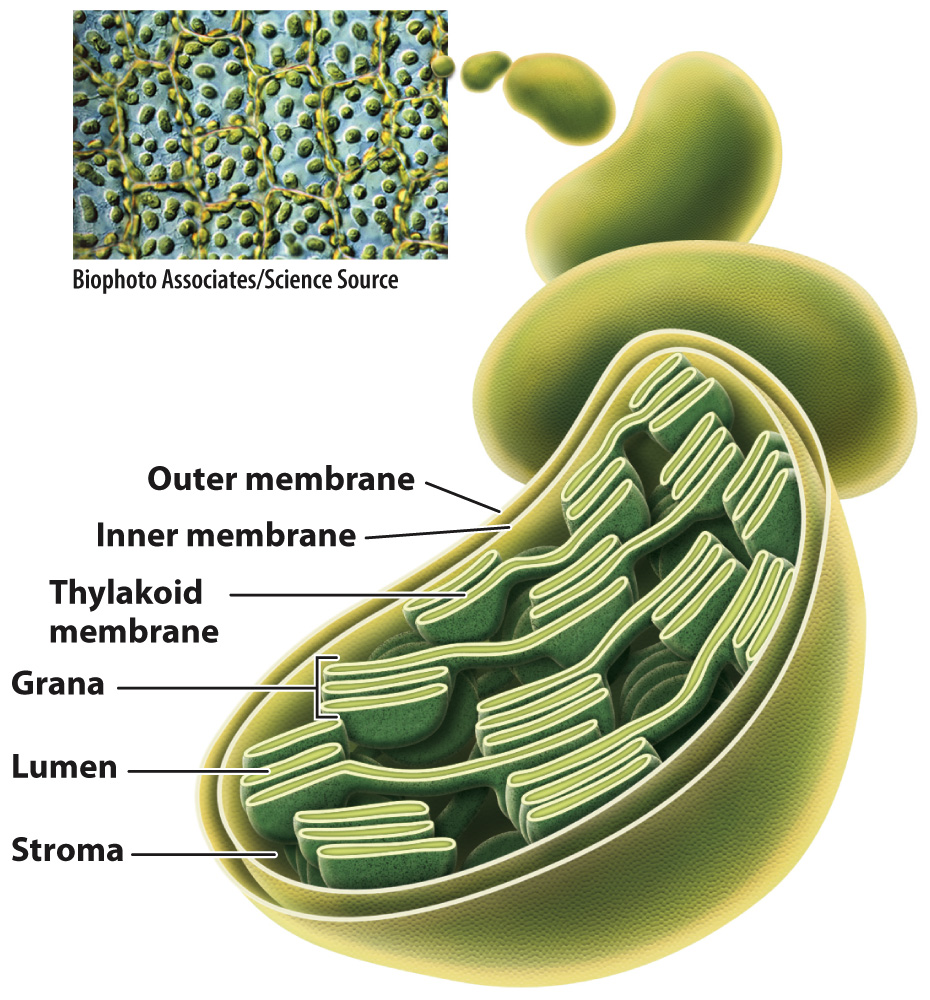The photosynthetic electron transport chain takes place on specialized membranes.

Electron transport chains play a key role in both photosynthesis and respiration (Chapter 7). In both cases, electrons move within and between large protein complexes embedded in specialized membranes. In photosynthetic bacteria, the photosynthetic electron transport chain is located in membranes within the cytoplasm or, in some cases, directly in the plasma membrane. In eukaryotic cells, photosynthesis takes place in chloroplasts. In the center of the chloroplast is the highly folded thylakoid membrane (Fig. 8.4). The photosynthetic electron transport chain is located in the thylakoid membrane.
The name “thylakoid” is derived from thylakois, the Greek word for “sac.” Thylakoid membranes form structures that resemble flattened sacs, and these sacs are grouped into structures called grana (singular, granum) that look like stacks of interlinked pancakes. Grana are connected to one another by membrane bridges in such a way that the thylakoid membrane encloses a single interconnected compartment called the lumen The region surrounding the thylakoid membrane is called the stroma. Carbohydrate synthesis takes place in the stroma, whereas sunlight is captured and transformed into chemical energy by the photosynthetic electron transport chain in the thylakoid membrane.
Although photosynthetic organisms are correctly described as autotrophs because they can form carbohydrates from CO2, they also require a constant supply of ATP to meet each cell’s energy requirements. Although ATP is produced within chloroplasts, only carbohydrates (and not ATP) are exported from chloroplasts to the cytosol. This explains why cells that have chloroplasts also contain mitochondria. In mitochondria, carbohydrates are broken down to generate ATP (Chapter 7). Cellular respiration is therefore one of several features that heterotrophic organisms like ourselves share with photosynthetic organisms.
We now consider the underlying biochemistry of photosynthesis. Though in this chapter we focus on photosynthesis as carried out by eukaryotic cells, there is a remarkable diversity in the way photosynthesis is carried out in bacteria. We discuss this diversity in Chapter 26. Because carbohydrates are the major product of photosynthesis, we first examine the Calvin cycle, the biochemical pathway used in photosynthesis to synthesize carbohydrates from CO2. Once we understand what energy forms are needed to drive this autotrophic pathway, we turn our attention to how energy is captured from sunlight. We then examine some of the challenges of coordinating these two metabolic stages and consider ways in which photosynthetic organisms cope with the inherent biochemical challenges of photosynthesis. Finally, we provide a short overview of the evolutionary history of photosynthesis.